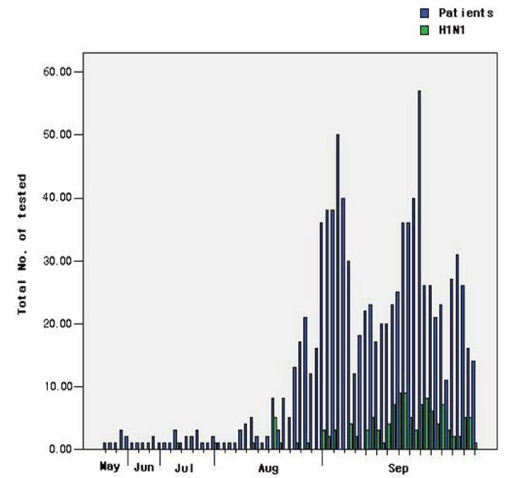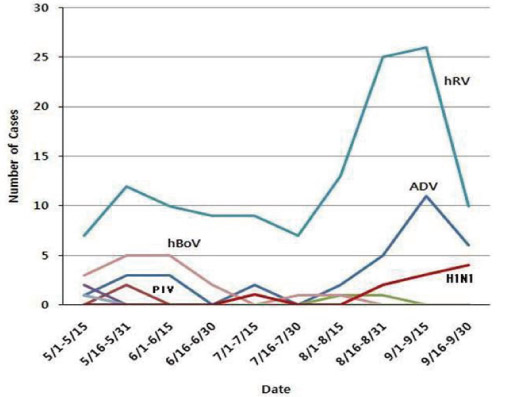Infect Chemother.
2010 Apr;42(2):76-81.
Clinical Characteristic of Respiratory Tract Infections in Children during Pandemic Influenza (H1N1 2009) in Korea
- Affiliations
-
- 1Department of Pediatrics, Yonsei University College of Medicine, Severance Children's Hospital, Seoul, Korea. dskim6634@yuhs.ac
Abstract
- BACKGROUND
Since initial emergence on pandemic influenza (H1N1 2009) in Mexico on March 2009, the first case of pandemic influenza (H1N1 2009) occured on 2 May 2009 in Korea. We describe the clinical characteristics of childhood patients from pandemic influenza (H1N1 2009) and other concurrent respiratory pathogens during early phase of the pandemic influenza in Korea.
MATERIALS AND METHODS
We have retrospectively studied 959 patients under age of 15 years who have visited Department of Emergency Medicine for a diagnostic test of pandemic influenza (H1N1 2009) or treatment of flu-like illness between May and September of 2009. The pandemic influenza (H1N1 2009) was detected via real-time RT-PCR and other respiratory viruses were detected via multiplex RT-PCR.
RESULTS
A total of 959 patients visited Department of Emergency Medicine at Severance Hospital. Of them, 562 were tested; 124 (12.7%) were positive for pandemic influenza (H1N1 2009). Confirmed patients of pandemic influenza (H1N1 2009) were relatively older than non-H1N1 patients (7.5 years of age vs 4.6 years, P<0.001). Among histories or symptoms of patients with flu-like illness, contact history (80%) with another patient with pandemic influenza (H1N1 2009) was an important clue of the infection in early phase of pandemic. Comparing with hospitalized patients with respiratory tract infections due to other causes, lower ESR (32.9+/-23.5 mm/hour vs 11.5+/-9.2 mm/hour), hyperkalemia (4.2+/-0.3 mmol/L vs 5.2+/-3 mmol/L) and hyponatremia (137.2+/-2.5 mmol/L vs 124+/-40.5 mmol/L) were significant laboratory finding and higher cholesterol and GTP were noticed in pandemic influenza (H1N1 2009). Ten confirmed patients with pandemic influenza (H1N1 2009) were hospitalized due to pneumonia and all of them were resolved without any complication.
CONCLUSIONS
Respiratory tract infections were caused not only by pandemic influenza (H1N1 2009) virus but also various respiratory viruses. Hospitalized patients, confirmed as pandemic influenza (H1N1 2009), showed a good prognosis. Age and contact history were distinct features and could be an important clue to differentiate causes in patients with febrile respiratory symptoms.
MeSH Terms
-
Child
Cholesterol
Diagnostic Tests, Routine
Emergency Medicine
Guanosine Triphosphate
Humans
Hyperkalemia
Hyponatremia
Influenza, Human
Influenza A Virus, H1N1 Subtype
Korea
Mexico
Multiplex Polymerase Chain Reaction
Pandemics
Pneumonia
Prognosis
Respiratory System
Real-Time Polymerase Chain Reaction
Respiratory Tract Infections
Retrospective Studies
Viruses
Cholesterol
Guanosine Triphosphate
Figure
Reference
-
1. Perez-Padilla R, de la Rosa-Zamboni D, Ponce de Leon S, Hernandez M, Quiñones-Falconi F, Bautista E, Ramirez-Venegas A, Rojas-Serrano J, Ormsby CE, Corrales A, Higuera A, Mondragon E, Cordova-Villalobos JA. INER Working Group on Influenza. Pneumonia and respiratory failure from swine-origin influenza A (H1N1) in Mexico. N Engl J Med. 2009. 361:680–689.
Article2. Novel Swine-Origin Influenza A (H1N1) Virus Investigation Team. Dawood FS, Jain S, Finelli L, Shaw MW, Lindstrom S, Garten RJ, Gubareva LV, Xu X, Bridges CB, Uyeki TM. Emergence of a novel swine-origin influenza A (H1N1) virus in humans. N Engl J Med. 2009. 360:2605–2615.
Article3. KCDC. Epidemiologic character ist ics of influenza A (H1N1) 2009 confirmed cases in Korea. Accessed 22 April 2010. Available at: http://cdc.go.kr/kcdchome/jsp/home/information/had/INFOHAD0001Detail.jsp?menuid=100053&appid=kcdchome&content=/contents/information/had/b/10125_view.html.4. Chowell G, Bertozzi SM, Colchero MA, Lopez-Gatell H, Alpuche-Aranda C, Hernandez M, Miller MA. Severe respiratory disease concurrent with the circulation of H1N1 influenza. N Engl J Med. 2009. 361:674–679.
Article5. Centers for Disease Cont rol and Prevent ion (CDC). Hospitalized patients with novel influenza A (H1N1) virus infection - California, April-May, 2009. MMWR Morb Mortal Wkly Rep. 2009. 58:536–541.6. Webb SA, Pettilä V, Seppelt I, Bellomo R, Bailey M, Cooper DJ, Cretikos M, Davies AR, Finfer S, Harrigan PW, Hart GK, Howe B, Iredell JR, McArthur C, Mitchell I, Morrison S, Nichol AD, Paterson DL, Peake S, Richards B, Stephens D, Turner A, Yung M. ANZIC Influenza Investigators. Critical care services and 2009 H1N1 influenza in Australia and New Zealand. N Engl J Med. 2009. 361:1925–1934.
Article7. World Health Organization. CDC protocol of realtime RT PCR for influenza A (H1N1). 2009. Accessed 30 April 2009. Available at: http://www.who.int/csr/resources/publications/swineflu/realtimeptpcr/en/index.html.8. Chun JK, Lee JH, Kim HS, Cheong HM, Kim KS, Kang C, Kim DS. Establishing a surveillance network for severe lower respiratory tract infections in Korean infants and young children. Eur J Clin Microbiol Infect Dis. 2009. 28:841–844.
Article9. Choi EH, Lee HJ, Kim SJ, Eun BW, Kim NH, Lee JA, Lee JH, Song EK, Kim SH, Park JY, Sung JY. The association of newly identified respiratory viruses with lower respiratory tract infections in Korean children, 2000-2005. Clin Infect Dis. 2006. 43:585–592.
Article10. Bharaj P, Sullender WM, Kabra SK, Mani K, Cherian J, Tyagi V, Chahar HS, Kaushik S, Dar L, Broor S. Respiratory viral infections detected by multiplex PCR among pediatric patients with lower respiratory tract infections seen at an urban hospital in Delhi from 2005 to 2007. Virol J. 2009. 6:89.
Article11. Fraser C, Donnelly CA, Cauchemez S, Hanage WP, Van Kerkhove MD, Hollingsworth TD, Griffin J, Baggaley RF, Jenkins HE, Lyons EJ, Jombart T, Hinsley WR, Grassly NC, Balloux F, Ghani AC, Ferguson NM, Rambaut A, Pybus OG, Lopez-Gatell H, Alpuche-Aranda CM, Chapela IB, Zavala EP, Guevara DM, Checchi F, Garcia E, Hugonnet S, Roth C. WHO Rapid Pandemic Assessment Collaboration. Pandemic potential of a strain of influenza A (H1N1): early findings. Science. 2009. 324:1557–1561.
Article12. Hospital Influenza Workgroup Singapore. Management of novel influenza epidemics in Singapore: consensus recommendations from the Hospital Influenza Workgroup (Singapore). Singapore Med J. 2009. 50:567–580.13. Nichols JE, Niles JA, Roberts NJ Jr. Human lymphocyte apoptosis after exposure to influenza A virus. J Virol. 2001. 75:5921–5929.
Article14. Cunha BA, Pherez FM, Schoch P. Diagnostic importance of relative lymphopenia as a marker of swine influenza (H1N1) in adults. Clin Infect Dis. 2009. 49:1454–1456.
Article15. Cao B, Li XW, Mao Y, Wang J, Lu HZ, Chen YS, Liang ZA, Liang L, Zhang SJ, Zhang B, Gu L, Lu LH, Wang DY, Wang C. National Influenza A Pandemic (H1N1) 2009 Clinical Investigation Group of China. Clinical features of the initial cases of 2009 pandemic influenza A (H1N1) virus infection in China. N Engl J Med. 2009. 361:2507–2517.
Article16. Crockett GS. Hypokalaemia in influenza. Br Med J. 1970. 2:178.
Article17. Kelly KJ, Garland JS, Tang TT, Shug AL, Chusid MJ. Fatal rhabdomyolysis following influenza infection in a girl with familial carnitine palmityl transferase deficiency. Pediatrics. 1989. 84:312–316.
Article18. Gomersall CD. Pro/con clinical debate: steroids are a key component in the treatment of SARS. Pro: Yes, steroids are a key component of the treatment regimen for SARS. Crit Care. 2004. 8:105–107.19. Tuvim MJ, Evans SE, Clement CG, Dickey BF, Gilbert BE. Augmented lung inflammation protects against influenza A pneumonia. PLoS One. 2009. 4:e4176.
Article
- Full Text Links
- Actions
-
Cited
- CITED
-
- Close
- Share
- Similar articles
-
- Clinical and Laboratory Characteristics of Pandemic Influenza A/H1N1 2009 Infection among Patients with Malignancy in Korea
- 2009 Pandemic Influenza A(H1N1) Infections in the Pediatric Cancer Patients and Comparative Analysis with Seasonal Influenza
- The 2009 H1N1 Pandemic Influenza in Korea
- A Case of Pandemic 2009 H1N1 Influenza A Manifestation as Apical Ballooning Syndrome
- Epidemiology, clinical manifestations, and management of pandemic novel Influenza A (H1N1)



